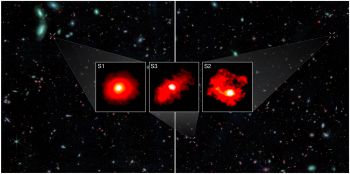News article
Scientists discover ‘Red Monster’ galaxies in the early Universe
Posted on behalf of: Lauren Ellis
Last updated: Friday, 15 November 2024

An international research team, including scientists from the University of Sussex, have discovered three ultra-massive galaxies – nearly as massive as the Milky Way –reshaping our understanding of galaxy formation in the early Universe.
A new study published in Nature this week shows that the Universe is forming stars more efficiently than initially expected.
Galaxies form gradually within large halos of dark matter. It was originally believed that only ~20% of gases in dark matter halos were converted into stars in galaxies. However, this new research reveals that massive galaxies developed in the early Universe (the period of time after the Big Bang) may have been much more efficient in building stars than previously thought and growing much more rapidly, raising new questions about galaxy formation theories.
The surprising discovery was made possible by the James Webb Space Telescope (JWST) FRESCO program, using the power of the NIRCam/grism spectroscopy,which aims to measure key physical properties of galaxies in the early Universe, including their spatial distribution, stellar masses (the mass of a star, typically measured in relation to the mass of the Sun, or solar mass) and star formation rate.
These unparalleled capabilities have allowed astronomers to systematically study galaxies in the very distant and early Universe, providing new insights into massive and dust-obscured galaxies. By analysing galaxies, scientists have shown that, to date, findings have been accurate to current galaxy formation theories about the structure and evolution of the Universe.
However, the most recent discovery showed three surprisingly massive galaxies, with stellar masses comparable to today’s Milky Way. These are forming stars nearly twice as efficiently as their lower-mass counterparts and galaxies formed at later times. Due to their high dust content, which gives them a distinct red appearance in JWST images, they have been named the three ‘Red Monsters’.
University of Sussex’s paper co-author, Longji Bing, Research Fellow in Extra-galactic Astrophysics says:
“These ‘Red Monsters’ are hardly visible in previous optical and near infrared data. Thanks to the unprecedented sensitivity of JWST imaging and spectroscopic observations, we could robustly determine their massive nature.”
The FRESCO program with the JWST aims to systematically analyse a complete sample of emission-line galaxies within the first billion years of cosmic history. This approach has enabled the team to achieve precise distance estimates and reliable stellar mass measurements for the full galaxy sample.
While these findings do not conflict with the standard cosmological model, they raise new questions for galaxy formation theories, specifically the issue of “too many, too massive” galaxies in the early Universe. Current models may need to consider unique processes that allowed certain early massive galaxies to achieve such efficient star formation and thus form very rapidly, very early in the Universe.
This exciting new research will invoke future observations with JWST and the Chilean Observatory, Atacama Large Millimeter Array (ALMA) to provide further insights into the ultra-massive ‘Red Monsters’ and reveal further samples to be analysed.
Dr.Mengyuan Xiao, lead author of the study and postdoctoral researcher at University of Geneva says:
“As we study these galaxies in more depth, they will offer new insights into the conditions that shaped the Universe’s earliest epochs.The 'Red Monsters' are just the beginning of a new era in our exploration of the early Universe.”